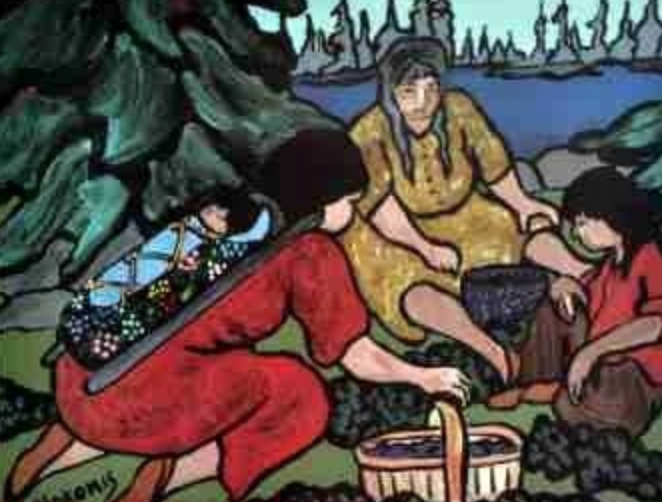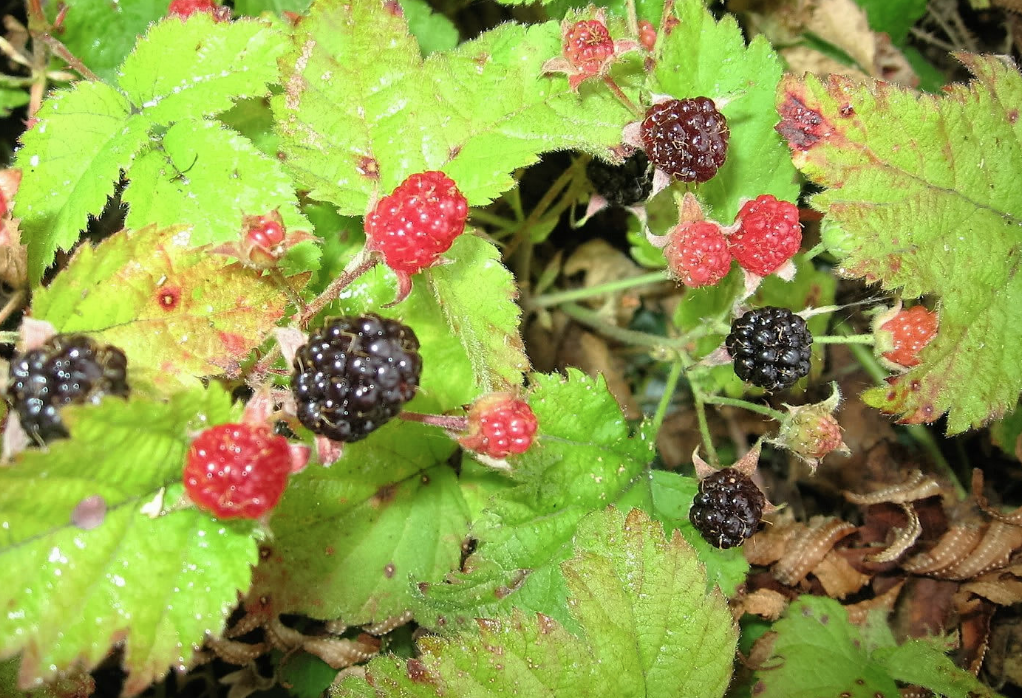Today, it is all about Berries!
Challenge starts June 1st and finishes June 15th
Here on Galiano Island, there is a big interest in ‘grazing’ through the woods. During the spring, we love to eat the new tips of a Douglas Fir, taste the young, bright green Salal leaves, and find some delicious Oyster Mushrooms after spring rains. One delicacy are the berries growing in every corner of the island, but the challenge is to find those delicious berries when they are ripe, before our cousins the animals do.

A berry is a small, moist and often edible fruit full of seeds. Berries do not have a pit or stones. Most of the time, they are very colourful and taste very sweet, but there also tart or sour tasting berries, such as the Oregon Grape Berries. Why would nature have put seeds in a good tasting and colourful pulp and not just have them light and … shape to fly away with the wind, as Dandelions do?
Plants have limited mobility, as they are rooted in place with great connection to other plants and mycorrhiza. To secure the passing on of their genes, plants disperse seeds and have developed different seed dispersal strategies through evolution. Different vectors, both abiotic and biotic, are utilized to facilitate seed dispersal.
Wind is one of the most common forces to disperse seeds away from its parent plant. It is an abiotic vector and provides lift to aerodynamic seeds, such as those of Maple trees, which spin like a helicopter through the air to carry them horizontally from the parent tree as they fall, and picks up lightweight seeds, such as fluffy Dandelion seeds, which can be carried by a light wind (such as a person’s blown breath) far away from the parent plant.
Water is also an abiotic vector and disperses the seeds of plants standing close to the water body. The seeds transported by water often have thicker skins, such as fruits, which can travel far by water. Water Lily’s, for example, create a fruit that floats in the water for a while and slowly settles down to the bottom to take root. Coconuts, one of the world’s largest seeds, are another example, and can be carried across oceans to wash up and take seed on a distant shore.
Lots of seeds are dispersed by animals, as biotic vectors. Berries attract birds, squirrels, raccoons, bears, and other animals through their diverse colours, tastes and forms. Some seeds need to pass an animals digestive system to germinate. The digestive system of an animal modifies the seed through chemical & physical changes and increases the survival of it, and within that germination.

Another way for a seed to travel with an animal is to get attached to an animal’s hair/fur (or a person’s clothes!) with hooks, or some sticky fluid–grass seeds you find in your socks after walking through a field in late spring or summer are a great example of this.

Humans have taken advantage of berries for millennia. Berry harvesting is a seasonal tradition for so many coastal First Peoples, who always had and still have an intimate knowledge of the local flora, knowing and using an innumerable amount of plant species for food, medicine, and other purposes.
Below are some of the more common native berries to keep an eye out for:
Salmonberry (Rubus spectabilis) is a deciduous shrub, that grows in wetland and riparian areas, but also establishes in disturbed areas. Salmonberry shrubs are 1-4 m tall, have erect or arching stems, and bloom from February to March/April with pink or rose-coloured flower. They are often found alongside Elderberry, Sword Fern, Evergreen Huckleberry and Fireweed. Salmonberry fruits ripen in May and June, are similar to raspberries and vary in colour (typically red to yellow) and taste depending on the plant and location.
The Salmonberry plant has always been very important for First Nation Peoples, who peel the new Salmonberry sprouts in spring, to eat them raw with cooked Salmon, or dried Salmon. Leaves are boiled as fish flavouring and berries are eaten fresh, rather than dried, because of their moisture content. Salmonberry is also used for medicinal purposes – infused leaves are used to treat anemia and to ease labour pains and dried leaves can be chewed to heal diarrhea and an upset stomach. The root of Salmonberry stimulates the appetite and promotes weight gain.
Trailing Blackberry (Rubus ursinus) is a native deciduous plant that grows mostly on the ground as a crawling shrub, however, it can also be found growing over other plants above the ground as a vine. Trailing Blackberry grows in a variety of ecosystems – wet to moist areas, dense forests, open areas, and disturbed sites. It can grow up to 5m long, but stays less than one meter tall. Leaves are set together as three leaflets, where the middle one is the largest. Leaves are finely toothed. Stems are prickly and appear blue/greyish, because of waxy coating.

Flowers of Trailing Blackberry are white and pink, have 5 petals and bloom from April throughout August. Male and female Trailing Blackberries are two separate plants. Berries are growing from April throughout August, depending on the ecosystem the plant is growing in. They are deep red to black and are congregated of many little drupes. The fruit is antioxidant and contains Vitamin A and Vitamin C. Berries are used as tea for most viral infections and leaves can be used as treatment for diarrhea and external washes for cuts, burns, and skin eruptions.
Tall Oregon Grape (Mahonia aquifolium) is an evergreen shrub, growing in dry forests and rocky open sites up to 2.5 m tall. Leaves on yellowish to reddish branches are thick and shiny with spiny, sharp teeth along the edge. Berries are smaller than grapes and grow in clusters. Harvested berries are used to make wine and to thicken Jams, as the occurring pectin is a natural thickener.
Indigenous peoples continuously use berries fresh and roots for dyeing baskets and other material. To treat poisonings, First Nation Peoples have taken a handful of berries from the Dull Oregon Grape to lower symptoms from early signs on until symptoms disappear. Dull Oregon Grape is the sister of Tall Oregon Grape.
Salal (Gaultheria shallon) is an evergreen shrub and the most common inhabitant in British Columbians understory. Salal belongs to the Ericaceae family and is found in forest edges, coniferous forests, wet forests and bluffs. It is 30 to 50 cm tall and can grow in perfect conditions up to 2 m high. As young plant the stems are green to red and by its 3rd to 4th year, stems develop a grey woody colour. The thick and shiny oval shaped leaves are alternating and are finely toothed. The white/pinkish flowers grow on a stock and have 5 lobes.
Salal berries can be harvested in late summer by the stock and are high in vitamin C and pectin. When berries have a deep purple colour, they are eaten fresh, or used as sweetener.
First Nation Peoples are using preserved berries during the winter – they were dried within a cake, or boiled on hot rocks. The leaves are used as an appetite suppressant. For trading purposes berries were mixed with currents and/or elderberries to make them last longer.
These are not the only Berries you can find on a Gulf Island – take a peek on the list below & go out with a guide book to identify all those delicious species:
Osoberry, Thimbleberry , Blackcap Raspberry, Red Huckleberry, Woodland Strawberry, Blue Elderberry, Red Elderberry, Saskatoon Berry, Oregon Grape, Wild Gooseberry, Red-flowering current, Soapberry, Kinnikinnick, Black Hawthorn, and Evergreen Huckleberry.
This Challenge is to create a Herbarium with one leave of each of the named berry plants & send a little video, or some pictures to deep@galianoconservancy.ca!
What is a Herbarium?
A Herbarium is a collection of pressed plant parts. Visit our last weeks DEEP Challenge about wildflowers and learn how to press plants!
The winner of this DEEP Challenge will be chosen through a little raffle of all the participants & will be announced June 17th!
Enjoy the stroll through our beautiful spring ecosystems! And btw, the Galiano Conservancy Association’s Millard Learning Centre is great to explore berry carrying plants!





